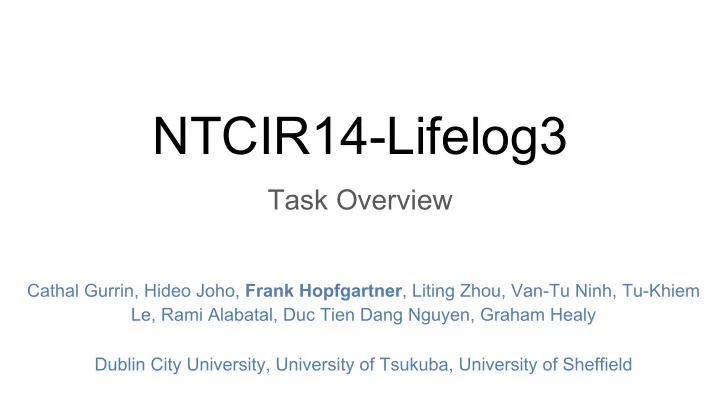

NTCIR14-Lifelog3 Task Overview Cathal Gurrin, Hideo Joho, Frank Hopfgartner , Liting Zhou, Van-Tu Ninh, Tu-Khiem Le, Rami Alabatal, Duc Tien Dang Nguyen, Graham Healy Dublin City University, University of Tsukuba, University of Sheffield
Reasons for Lifelog Analytics
Lifelog-3 Overview The third of three lifelog tasks at NTCIR. New rich data (43 days, 2 people), fully anonymised in a semi-automated process Three sub-tasks: LSAT - Lifelog Semantic Access Task LIT - Lifelog Insights Task LADT - Lifelog Activity Detection Task
Lifelog-3 Data (smaller but richer)
LSAT Sub-task A known-item search task in which participants have to retrieve a number of specific moments in a lifelogger's life. We define moments as semantic events, or activities that happened throughout the day. LSAT can be undertaken in an interactive or automatic manner.
LSAT Topics (24) Ice cream by the Sea Cooking a BBQ Eating Fast Food light Check-in A New TV Mirror Going Home by Train Meeting with a Lifelogger Photograph of a Bridge Seeking Food in a Fridge In a Toyshop Car Sales Showroom 7* Hotel Watching Football Buying a Guitar Coffee with Friends Empty Shop Dogs Card Shopping Eating at the desk Croissant & Coffee Walking Home from Work Scone for Breakfast Crossing a Bridge
LSAT Results (overview paper for details)
Traveling LADT Sub-Task Face-to-face interacting Using a computer Cooking The LADT subtask aimed to identify Eating Time with children Activities of Daily Living (ADLs) from Houseworking lifelogs, which have been employed as Relaxing indicators of the health of an individual. Reading Socialising NTU group (Taiwan) took part in the Praying LADT task and developed a new Shopping Gaming approach for the multi-label Physical activities classification of lifelog images. Creative activities Other activities
LIT Sub-Task ● Generate insights from lifelogs ● Inspired by Quantified Self movement
LIT Sub-Task One group took part in the LIT task. THUIR (China) developed a number of detectors for the lifelog data to automatically identify the status/context of a user: inside/outside status, alone/not alone status working/not working status. Operate over non-visual and visual data. A comparison between the two approaches showed that the visual features (integrating supervised machine learning) were significantly better than non-visual ones based on metadata.
NTCIR LIFELOG DATASETS
NTCIR Lifelog Tasks ● Have a look at our draft book chapter ● http://sakailab.com/ntcirbookdraft/
NTCIR LIFELOG LEARNINGS ● The best performing retrieval systems have enhanced the provided metadata by relying on additional visual concept detectors. ● There was a lexical gap between the terms used by the lifeloggers in their topic descriptions, and the indexed textual content and annotations. ● Integration of external WWW content has positive results. ● Interactive systems have been increasing in interest since NTCIR-12 and the Lifelog Search Challenge (LSC at ICMR) has been started to specifically explore this challenge. ● Document segmentation remains an unsolved challenge. ● There is an observed interest in retrieval and insight generation from lifelog data.
NTCIR LIFELOG – WHAT’S NEXT? At NTCIR-15, we are proposing a new pilot task to replace the Lifelog ● task. This pilot task (called MART) is concerned with micro-activity detection , which we feel is more aligned with the Information Retrieval focus of NTCIR. Micro-activities are small everyday tasks such as ’writing an email’, ● making a sandwich, daydreaming, etc.
NTCIR LIFELOG - MART Data ● Timestamped lifelog camera data from a wearable camera (similar to lifelog) ● EEG (Electroencephalography) to capture brain activity levels. ● EOG (Electrooculogram) to capture eye movements. ● GSR (Galvanic Skin Response) to capture skin conductivity, a correlate of stress levels. ● HR (heart rate) of the individual. ● Accelerometer (movement at multiple points) on the body. ● Detailed Computer Interactions (using loggerman software) to capture information. ● Facial expressions via inbuilt webcams.
Participate in … MART pilot task at NTCIR-15 (?) Lifelog Search Challenge (LSC 2020) in Dublin Ireland, at ICMR 2020.
Recommend
More recommend